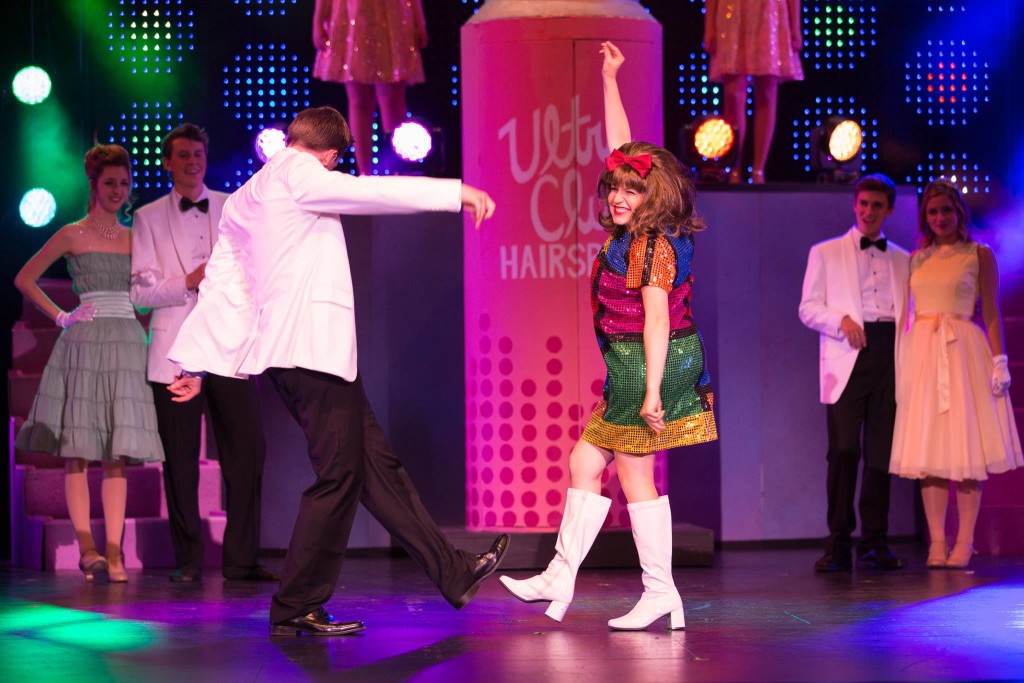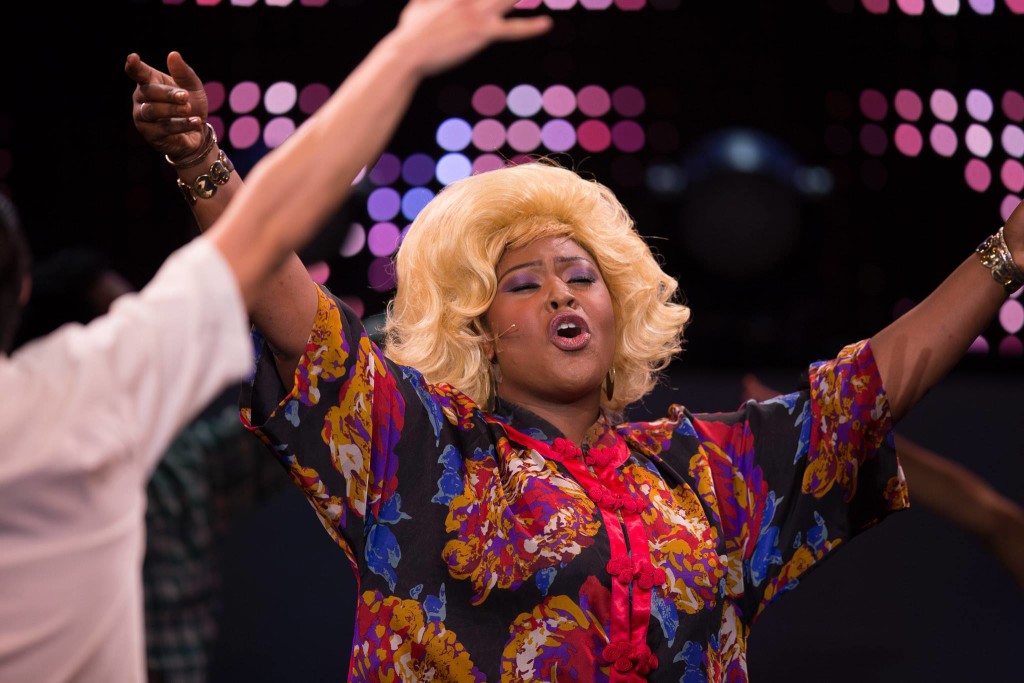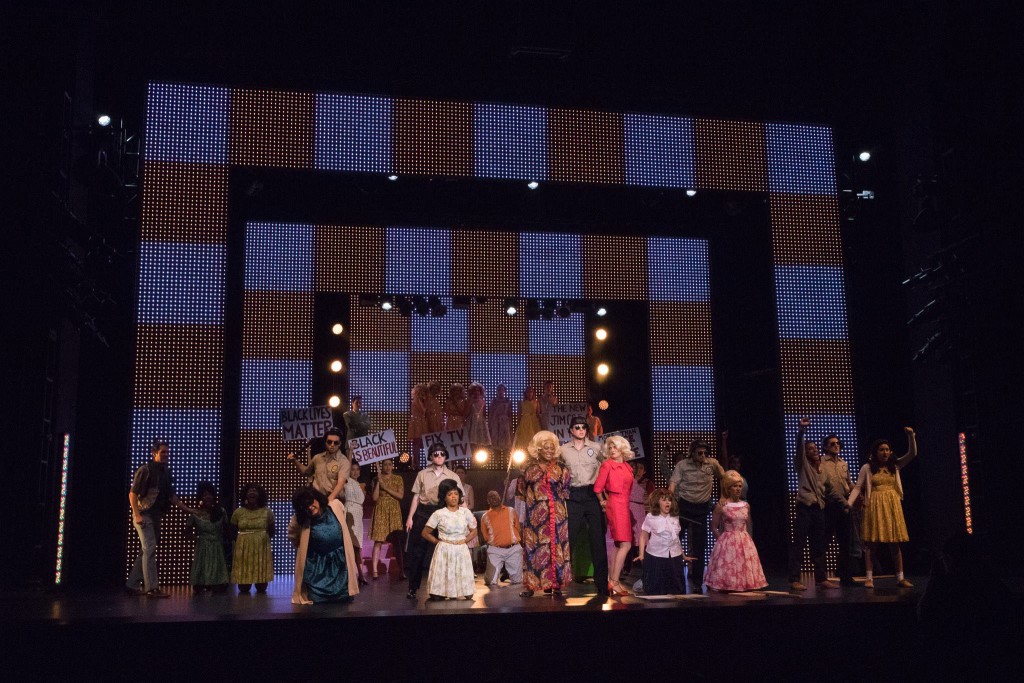
If there is anything the board members of Ram’s Head Theatrical Society will learn from putting on the spring production of Hairspray, it is that they should not choose a show for which they cannot find the right people. The show is exciting, powerful, and inspiring, but lacks both dancing talent and nuance in its treatment of race; and no number of LED lights, not even a mind-boggling twenty thousand, can make up for that.
This is not to say that the production is not spectacular. The story is a comedic minefield, with a wisecrack hidden in almost every line of priceless dialogue, every note of upbeat music, and every carefully choreographed kick. It is clear that the show features some of Stanford’s strongest singers, actors, and dancers. While not every dancer sings, every singer does dance, and this is where the rub lies. The impeccable dance ensemble tries to carry the weight of its singing counterpart, but rarely succeeds in masking the lack of dancing beat in those who can sing.
Insofar as acting is concerned, Hairspray does not lend itself easily to serious artistic stretches. All of the characters represent caricatured versions of the real people they tend to emulate; they come to unlikely decisions, utter uproarious things, and sometimes even rhyme when they talk to one another. But to say this shallowness makes the musical lesser is folly, when it is precisely that shallowness that endows the show with incredible comedic momentum; and indirectly, makes it possible for the funny story to hint at more profound meaning.
Matt Herero clearly carries this humorous essence. His hair perfectly coiffed and his face beaming with inexhaustible pizzazz, Herero’s Link Larkin leads the rest of the Nicest Kids in Town—the white people starring on the Corny Collins Show—in a manner that is at the same time exaggerated and hilarious. Sadly, not all of the Nicest Kids seem to have gotten the memo that they are supposed to be Stepfordians, and not Shakespeareans. Their smiles need to be bigger, their eyes wider, and their attitude farther over the top if they are to portray the bright-eyed Baltimore favorites.
Three of the show’s vocal highlights are the devastatingly talented Ladidi Garba, who plays powerhouse DJ Motormouth Maybelle, her son Seaweed, played by the incredible Robert Poole (one of the few actors in this production who can dance), and the fantastic Hannah Hsieh, who stars as Tracy’s best friend, Penny Pingleton. Among them, Garba stands out as the sun-shattering auditory pinnacle of this production - she has a voice that deserves to find attention in productions beyond this one. Hopefully, in professional spheres.

The funniest actors in Hairspray are Nick Biddle and Brady Richter as Edna and Wilbur Turnblad. Working with impeccable comedic timing, this duo’s rendition of “Timeless to Me” is deeply endearing, redeeming some of the other actors’ less-than-stellar acting choices. Richter as Wilbur Turnblad reminds of his equally entertaining performance of “Master of the House” as Monsieur Thénardier in last year’s Les Miserables, where he performed alongside Hairspray lead Jessia Hoffman as his wife, Madamme Thénardier. It is as though the Thénardiers have been dry-cleaned, vigorously bedazzled, and transformed into the eccentric old farts that can’t keep their hands off each other.
There is nobody at Stanford who could play Tracy Turnblad better than Jessia Hoffman. Her stage presence is nothing short of gut-busting; she delivers her zingers with the exactitude expected of a professional performer. When Link Larkin tells her she is beautiful, Tracy responds with “It must be the low-watt institutional lighting.” This is one of the show’s funniest lines, and Hoffman serves it to the audience with the exact type of dim-witted enthusiasm as would be expected of a smitten Tracy. Triple threats are, however, becoming increasingly rare in theatre and Hoffman does not fully embody the dancing abilities expected of a show lead. This makes the story less believable, because Tracy is supposed to make it onto the Corny Collins Show based on how well she dances.
Tracy landing on the Corny Collins Show carries an implicit message about race in Hairspray. She dances well, but she also dances differently from the other white people on the show. This is because she borrows her dance moves from Seaweed, who is black. White co-opting of black culture is but one of the many matters of race that this production attempts to, but ultimately does not address. Instead, Tracy simply thanks Seaweed for showing her the awesome moves that got her on the show, and then helps him get on it as well in the show’s triumphant finale. With the commendable adjustments director Ken Savage has done to fit Asian Americans into the story of 1962 Baltimore (Penny Pingleton and her mother are Asian), he asserts himself as a racially conscious director. If Savage knows that this is a racially charged show and aims to tackle its story in an inventive way, why does he not shift the script and comment on appropriation?

Moreover, the production’s widely publicized connection between the 1960s Civil Rights Movement and #BlackLivesMatter becomes reduced to a mere sign in the protest scene. After that, when Tracy and her friends (both black and white) get arrested, nobody gets hurt by the police, and then Tracy’s father puts a mortgage on his shop to bail them out. This does not reflect the current American political reality. Institutional violence against black and brown people results in trauma, destruction, death, and the systemic erasure of identities that do not fit within the ideologically prescribed frameworks of society. In the real world to which Savage’s production aims to appeal, there is no Wilbur Turnblad to pawn his shop and save the blacks. Why do the comedic rules of unlikely decisions and uproarious utterance continue to ring true in a situation that is distinctly more serious than the rest of the show?
Comedy’s power lies in its ability to blast open cluttered conversations - about race, gender, and class, among other things. This production of Hairspray excels at comedy, which provides the setup so that the production can hint at deeper meaning. Amidst the incredible dancers, the side-splitting acting, and the soaring vocals, Hairspray forgets about the latter part of the equation, which makes this revival slightly less radical.
Photos by Frank Chen
Hairspray: 8 p.m. April 10-11, 16-18. Memorial Auditorium. Tickets at http://musical.stanford.edu/tickets.html.

Concerned Citizen
April 12, 2015 at 1:08 am (2 years ago)Dearest Bojan,
The community greatly appreciates your carefully thought out analyses of the various aspects of this student production. However, we have but one question: can YOU dance??
All Best,
A Concerned Citizen of the Stanford Arts Community
PS - please do consider writing your own damn musical, especially if you expected that a production attempting to mimic the social atmosphere of the 1960s should be as progressive and politically correct as that of today.
[email protected]
April 13, 2015 at 9:24 pm (2 years ago)Hi Concerned Citizen,
What you seem to be getting at (behind your outrage) is a question about the nature of criticism and the place of the critic within Stanford’s growing on-campus arts scene. I’m also not really sure that it is a matter of whether I can dance or write musicals.
Happy to keep talking, but let’s keep it respectful.
Bojan
Anonymous
April 12, 2015 at 10:43 am (2 years ago)This seems like more of a commentary on the script itself than the actual production. What… Do you expect Ken Savage to rewrite the whole script, keep its fidelity to the original playwright and touch on every bad thing that’s happening in the world today? This isn’t an original script, so don’t review it as if it were. Secondly, keep in mind that this is a COLLEGE production, not Broadway, so of course not everyone will be a professional dancer. And even as a college production, Hairspray still soars. Ken Savage can only do so much with a script, that I will stress again, HE didn’t write. And what he HAS done is stunning. This review is utterly ridiculous.
[email protected]
April 13, 2015 at 9:20 pm (2 years ago)Hi Willie,
All great points.
Since the production took it upon itself to handle matters of race in the story by, among other things, changing the race of the characters and adding props to establish a (relatively weak) connection to the #BlackLivesMatter movement, I thought it was confusing that it did not pay attention to other matters of race that are equally salient to living in a racialized society today. These include appropriation and police brutality, which I addressed in my piece. As someone who participated in the early Silicon Shutdown protests (October-December 2014), I felt that this production was capitalizing on a sensitive moment to be black in America without carefully handling the content of the story. I also think there are many ways to direct any given moment in the show (note that this does not involve re-writing the script) and pay attention to the salient matters that I spoke of before.
Insofar as the “college production” part of your argument goes, I just want to point out the following: What a college arts publication can do to support on-campus productions does not only include being blindly complimentary to everything that gets staged, but also providing pointers for the involved artists’ further development. The Arts Review is no exception to this guideline. We cannot respect ourselves as writers/journalists if all we write are undeserved hype pieces that ultimately serve nobody.
Happy to keep talking about this,
Bojan
Willie
April 13, 2015 at 10:33 pm (2 years ago)Thank you for your response, Bojan. I’m also interested in continuing this conversation. I’ll follow up soon.
Anonymous
April 12, 2015 at 4:38 pm (2 years ago)I have to agree that this review is entirely off topic. Instead of critiquing the original script as if that’s at ALL what you’re supposed to do, focus on the production itself.
Alma
April 13, 2015 at 1:13 am (2 years ago)Excellent review. Bravo Bojan.
Concerned
April 13, 2015 at 4:49 pm (2 years ago)Interesting it would seem that professional writers disagree with your analysis of the dancing. From Palo Alto Weekly: “Ram’s Head Theatrical Society, Stanford’s oldest student-run theater group, has hit the triple-threat jackpot in casting its current production of ‘Hairspray,'” Although you are just a student (like all the performers) and one day you will learn the difference between good and bad!
[email protected]
April 13, 2015 at 9:05 pm (2 years ago)Hi Concerned,
Thanks for writing. I’m not sure it’s really a matter of professional or amateur writing, but about honesty and one’s own perception of a piece of art. If it helps you take my writing a little more seriously; I have written for the feature and business sections of The San Francisco Chronicle, and have been featured on the front page multiple times.
However, I do not think a person’s professional background (or lack thereof) needs to inform what one thinks of a piece of writing. I think it has a lot more to do with the content of the piece. But there is a world of opinions out there, and mine is just one of them, so I can respect what you’re saying, even if I disagree with it.
Again, thanks for checking in!
Bojan
You Know
April 14, 2015 at 5:36 pm (2 years ago)proud of you for being wholeheartedly you.
Yash Saraf
May 28, 2015 at 3:47 am (2 years ago)Hey Bojan,
I just wanted to congratulate you on a great article.
You have pointed out the show’s obvious strengths, and your criticism - at least to my mind - is addressing not the dirth in the original script, so much as it’s addressing an opportunistic jab at connecting Hairspray to contemporary issues of race. Surely a weak reference to contemporary issues is not equivalent to ‘re-imaginging race through Hairspray’.
I applaud your review, and am grateful that honest criticism is still a thing. The show was spectacular entertainment, but it was not political/social commentary, and shouldn’t pretend to be.
Best,
Yash
[email protected]
May 28, 2015 at 10:43 am (2 years ago)Cheers, Yash. I think you’re on the money with your insight. It’s my hope that people will understand the political implications of the art they make, and not monopolize moral high grounds for the purpose of ticket sales.